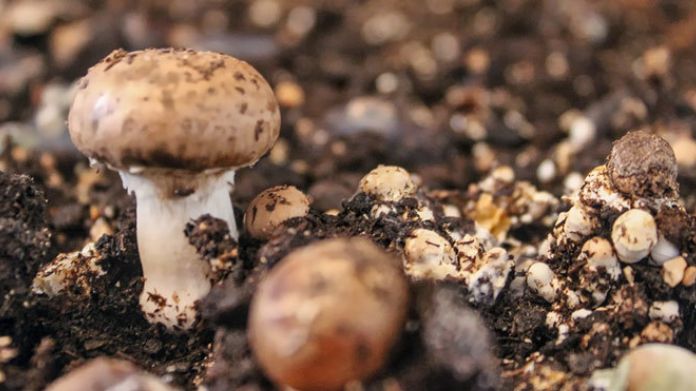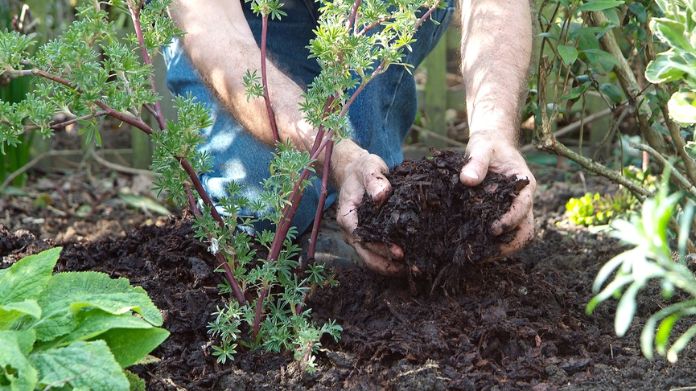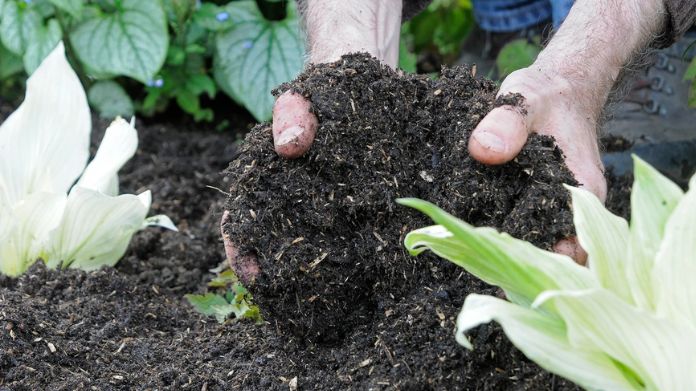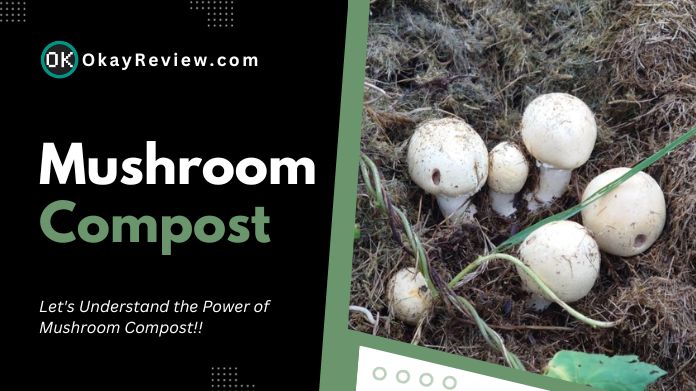Mushroom compost has emerged as a game-changer in gardening and agriculture. A by-product of the mushroom cultivation process, this unique compost offers a blend of organic richness that can transform the health and vitality of your soil.
But what exactly is mushroom compost, and how can gardeners harness its potential?
This article delves deep into the nuances of this compost, unraveling its composition, benefits, and the best practices for its application.
Whether you’re a seasoned gardener or just starting, understanding the power of mushroom compost can be the key to a thriving garden.
Join us as we explore the world of mushroom compost and its transformative impact on gardens and landscapes.
Table of Contents
What is Mushroom Compost?
Mushroom compost, often termed “spent mushroom compost,” is a valuable by-product of the edible industry. This unique compost emerges from a blend of decomposed straw and well-rotted animal manure, predominantly from horses and chickens.
After cultivating mushrooms on this mix, the compost undergoes a sterilization process, eliminating potential pests, diseases, or weeds.
This ensures that when gardeners use it, they introduce a rich, organic matter to their soil, enhancing its structure and nutrient content.
Not only it improve soil aeration and moisture retention, but it also provides essential nutrients that plants crave.
Whether you’re looking to enrich your ornamental garden or boost your vegetable yield, mushroom compost is a top choice for gardeners seeking an organic, effective soil conditioner.
Benefits of Using Mushroom Compost

- Rich Organic Matter: It introduces a wealth of organic material to the soil, enhancing its overall quality and vitality.
- Improved Soil Structure: Adding mushroom compost helps break down compacted soils, promoting better root growth and water infiltration.
- Enhanced Moisture Retention: With this compost, soils can retain moisture more effectively, reducing the need for frequent watering.
- Boosted Nutrient Content: It is a rich source of crucial nutrients such as nitrogen, phosphorus, and potassium, all pivotal for the growth of plants.
- Natural Soil Conditioner: Unlike chemical fertilizers, it is an organic soil conditioner, making it environmentally friendly.
- Increased Soil Aeration: The compost promotes better air circulation within the soil, ensuring roots receive ample oxygen.
- Pest and Disease Resistance: The sterilization process ensures it’s free from harmful pests, diseases, and weed seeds.
- Sustainable Gardening: Using it supports sustainable and organic gardening practices, reducing the reliance on synthetic products.
- Supports Microbial Activity: The organic matter in it fosters beneficial microbial activity, promoting a healthier soil ecosystem.
- Versatility: Suitable for ornamental and vegetable gardens, it is a versatile addition to diverse gardening needs.
Where and When to Use Mushroom Compost?
 Mushroom compost is a versatile soil amendment that can be integrated into various gardening scenarios. Ideally, it’s best to apply it in the spring, setting the stage for a productive growing season.
Mushroom compost is a versatile soil amendment that can be integrated into various gardening scenarios. Ideally, it’s best to apply it in the spring, setting the stage for a productive growing season.
When considering where to use it, gardeners can spread a layer on flower beds, herbaceous and shrub borders, and around young trees to enrich the soil and promote healthy plant growth.
This compost is particularly beneficial for improving heavy clay soils, enhancing drainage capabilities, and amending light, free-draining soils by boosting their moisture retention.
However, it’s essential to exercise caution with acid-loving or ‘ericaceous’ plants like rhododendrons and azaleas, as the slightly alkaline nature might not suit their nutrient needs.
Additionally, while it is a boon for vegetable beds, it’s advisable to avoid using it on soft fruits that prefer neutral to acidic conditions.
The Process of Making Mushroom Compost
- Selection of Raw Materials: The initial creation step involves gathering the primary ingredients. These typically include straw, water, and well-rotted animal manure, especially from horses and chickens.
- Chopping and Mixing: The straw is chopped into smaller pieces to facilitate faster decomposition. Once chopped, it’s mixed with the animal manure to create a balanced substrate.
- Wetting the Mix: Water is added to the mixture to initiate the composting process. The moisture aids in breaking down the organic materials.
- Composting Phase: The wet mixture is left to compost, turning it periodically to ensure even decomposition. This phase allows it to heat up, which aids in breaking down the materials and killing any potential pathogens.
- Pasteurization: After composting, the mixture undergoes a pasteurization process. This involves heating the compost to a specific temperature to eliminate any remaining pests, diseases, or weed seeds.
- Cooling Down: Post-pasteurization, it is allowed to cool down. This ensures it’s at the right temperature for mushroom cultivation.
- Mushroom Cultivation: Mushrooms are then cultivated on this prepared substrate. They derive their nutrients from the compost, growing and fruiting over several weeks.
- Harvesting: Once the mushrooms mature, they are harvested. The compost has served its primary purpose.
- Sterilization: The spent mushroom compost undergoes another round of sterilization to ensure it’s free from harmful pathogens.
How to Use Mushroom Compost in Your Garden?
 For both flower beds and vegetable patches, it’s advised to either sprinkle a layer of it on top or mix in approximately three inches of the compost into the upper six inches of the garden’s soil.
For both flower beds and vegetable patches, it’s advised to either sprinkle a layer of it on top or mix in approximately three inches of the compost into the upper six inches of the garden’s soil.
However, due to its high soluble salt content, it’s not suitable for all plants. It’s best to avoid using it with salt-sensitive plants and young plants.
A compost tea, made by mixing compost with water, can serve as a liquid fertilizer and is rich in beneficial microorganisms.
Comparing Mushroom Compost to Traditional Mineral Fertilizers
1. Origin
Mushroom Compost: A natural by-product of the mushroom cultivation process.
Mineral Fertilizers: Chemically formulated to provide specific nutrients.
2. Nutrient Release
Mushroom Compost: Offers a slow and steady release of nutrients, ensuring prolonged nourishment.
Mineral Fertilizers: Often provide a quick nutrient boost, which might require frequent reapplications.
3. Soil Health
Mushroom Compost: Enhances soil structure, aeration, and moisture retention. Introduces beneficial microorganisms.
Mineral Fertilizers: Primarily focus on nutrient provision without significantly improving soil health or structure.
4. Environmental Impact
Mushroom Compost: Eco-friendly and sustainable, promoting a balanced soil ecosystem.
Mineral Fertilizers: It can sometimes lead to nutrient runoff, potentially harming aquatic ecosystems.
5. Application
Mushroom Compost: Can be mixed into the soil or used as a top layer, integrating organically over time.
Mineral Fertilizers: Typically sprinkled or spread over the soil, requiring incorporation.
6. Longevity
Mushroom Compost: Offers long-term benefits, improving soil health over extended periods.
Mineral Fertilizers: Effects might be short-lived, necessitating regular applications.
7. Microbial Balance
Mushroom Compost: Encourages a thriving microbial ecosystem in the soil.
Mineral Fertilizers: Some types can disrupt the natural balance of soil microbes.
Conclusion
Mushroom compost is an invaluable addition to any garden, offering many benefits.
By understanding its properties and appropriate usage, gardeners can harness its full potential for healthier plants and enriched soil.

